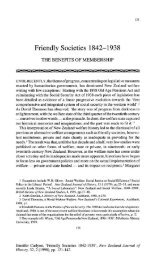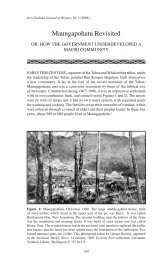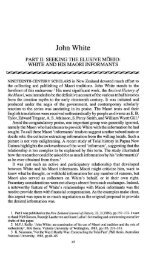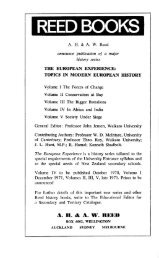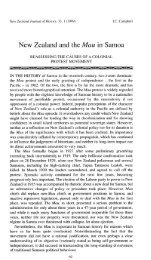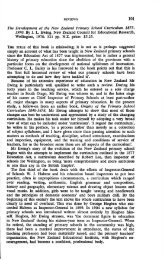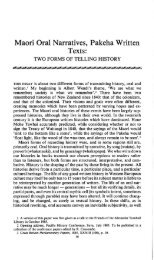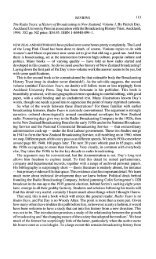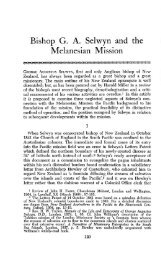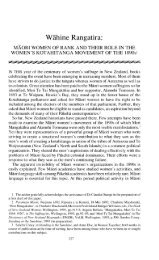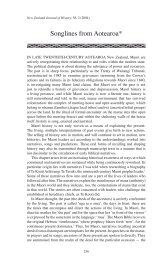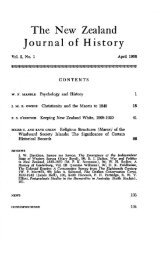Irish Migration to the West Coast, 1864-1900 - New Zealand Journal ...
Irish Migration to the West Coast, 1864-1900 - New Zealand Journal ...
Irish Migration to the West Coast, 1864-1900 - New Zealand Journal ...
Create successful ePaper yourself
Turn your PDF publications into a flip-book with our unique Google optimized e-Paper software.
198<br />
LYNDON FRASER<br />
succession <strong>to</strong> <strong>the</strong> land. The death of <strong>the</strong>ir fa<strong>the</strong>r marked an end <strong>to</strong> <strong>the</strong> transitional<br />
period between each of <strong>the</strong>se events and opened <strong>the</strong> way for a fur<strong>the</strong>r reduction<br />
in <strong>the</strong> size of <strong>the</strong> family household at <strong>West</strong> Gragan. John's voyage <strong>to</strong> Vic<strong>to</strong>ria<br />
aboard <strong>the</strong> Eastern Empire in mid-1863, and <strong>the</strong> later arrival of his mo<strong>the</strong>r and<br />
three younger siblings on <strong>the</strong> White Star, completed a complex process that<br />
involved <strong>the</strong> transfer of land at home and <strong>the</strong> transplantation of non-inheriting<br />
children abroad. 3<br />
No written account of John Callinan's subsequent movements in Australasia<br />
survives, although it is clear that he chose not <strong>to</strong> remain permanently in<br />
Melbourne. Parish records show that he married Bridget O'Neil, a farmer's<br />
daughter from <strong>New</strong>market, County Tipperary, at <strong>the</strong> Roman Catholic Chapel in<br />
Euroa on 2 January 1871. The couple made for <strong>the</strong> prosperous agricultural district<br />
of Kyne<strong>to</strong>n later that year and <strong>the</strong>ir eldest surviving child, Ca<strong>the</strong>rine, was born<br />
<strong>the</strong>re in 1872. 4 Although <strong>the</strong> available evidence is ambiguous, it seems likely<br />
that <strong>the</strong> presence of kinsfolk in <strong>West</strong>land may have encourage <strong>the</strong>m <strong>to</strong> seek new<br />
opportunities across <strong>the</strong> Tasman. The Callinans landed at <strong>the</strong> flourishing port<strong>to</strong>wn<br />
of Hokitika in 1874 and settled in an isolated hinterland community some<br />
distance from Goldsborough. Bridget gave birth <strong>to</strong> two more children — Kate<br />
and James — during <strong>the</strong>ir sojourn on <strong>the</strong> diggings and must have found life<br />
onerous in <strong>the</strong> wretched conditions of <strong>the</strong> mining camp. After several years of<br />
struggle, <strong>the</strong> couple abandoned <strong>the</strong> Waimea and shifted north <strong>to</strong> Brunner<strong>to</strong>n,<br />
where John found steady work as a coal-miner. Three decades of continuous<br />
residence in <strong>the</strong> small mining <strong>to</strong>wnship were broken only by an unsuccessful<br />
stint at hotel-keeping in <strong>West</strong>port, which ended in bankruptcy in 1902. This<br />
misadventure prompted John's return <strong>to</strong> wage labour in Brunner<strong>to</strong>n and later in<br />
Greymouth. It was here that he remained, outliving his wife and two eldest<br />
children, before dying at Kotuku in April 1933. The funeral attracted 'a numerous<br />
attendance of friends', many of whom travelled 'from <strong>the</strong> country districts' <strong>to</strong><br />
witness <strong>the</strong> burial of an <strong>Irish</strong> tenant farmer's son in <strong>the</strong> Catholic section of <strong>the</strong><br />
Kararo cemetery. 5<br />
John and Bridget Callinan were among several thousand <strong>Irish</strong> men and women<br />
who settled on <strong>the</strong> <strong>West</strong> <strong>Coast</strong> of <strong>New</strong> <strong>Zealand</strong>'s South Island during <strong>the</strong><br />
nineteenth century. Like <strong>the</strong> Callinans, most of <strong>the</strong>se newcomers made <strong>the</strong>ir<br />
way <strong>to</strong> <strong>the</strong> region from <strong>the</strong> Australian colonies and many belonged <strong>to</strong> expatriate<br />
social networks that extended back and forth across <strong>the</strong> Tasman. Despite <strong>the</strong><br />
importance of <strong>the</strong>se connections, <strong>the</strong> <strong>West</strong> <strong>Coast</strong> <strong>Irish</strong> have attracted little<br />
attention from scholars exploring <strong>the</strong> various diasporic communities scattered<br />
throughout Australasia. 6 There exists no detailed treatment of <strong>the</strong>ir s<strong>to</strong>ry and<br />
we still await a regional equivalent of Malcolm Campbell's fine-grained portrait<br />
of <strong>the</strong> <strong>Irish</strong> in south-western <strong>New</strong> South Wales. 7 Yet <strong>the</strong> same mechanisms that<br />
bound <strong>the</strong> parish of Clonoutly <strong>to</strong> Boorowa, and Dromore <strong>to</strong> Illawarra, also<br />
connected Burawn with Charles<strong>to</strong>n, Kilrush with Kumara, and Skibbereen with<br />
Addison's Flat. The <strong>Irish</strong> pattern of settlement was largely a self-perpetuating<br />
phenomenon that sustained a complex web of linkages stretching from Nelson<br />
Creek <strong>to</strong> Ballarat, and from south <strong>West</strong>land <strong>to</strong> distant parishes in County Clare.<br />
In common with <strong>the</strong>ir contemporaries who emigrated <strong>to</strong> eastern Australia, <strong>the</strong><br />
<strong>West</strong> <strong>Coast</strong> <strong>Irish</strong> constructed enduring ties of kinship and acquaintance that



